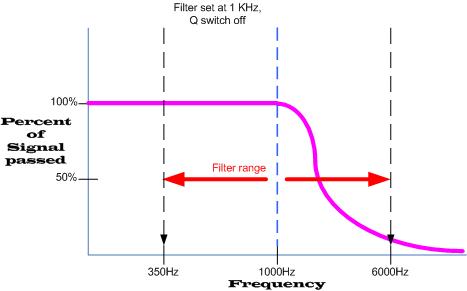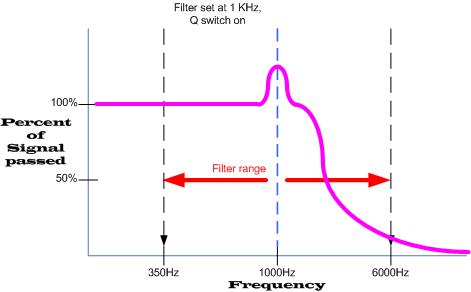| Author | Message | ||
| richbass939
Member Username: richbass939 Post Number: 52 Registered: 11-2004 |
Okay, I've looked through the website and read a lot of Club posts. I still don't have much of a handle on the function of the Q. Low pass filter? Not a clue. What exactly do they do? How do they differ on the different models? How do you guys use them for different types of music and in different gig situations? Rich | ||
| davehouck
Senior Member Username: davehouck Post Number: 1116 Registered: 5-2002 |
Here's a quote from Val: "The frequency range of the filters is 350 to 6000hz. If you roll the filter all the way forward everything gets through, if you roll it all the way back, then the frequencies over 350hz are cut off; obviously you have all sorts of different settings available in between these extremes. The 'q' switch is on when flipped down, and gives you roughly an 8db boost at the cutoff frequency you select on the corresponding filter." | ||
| richbass939
Member Username: richbass939 Post Number: 54 Registered: 11-2004 |
Thanks, Dave, for the response. So if you roll the filter (say on a 1-10) to 3 it may let the freqs through up to 1000, set on 7 letting freqs up to 4500 through? The numbers I used are arbitrary, of course, but is that the right idea? I guess there is a Q paired with a filter? I suppose there is a Q-filter set for each pickup? Rich | ||
| bsee
Senior Member Username: bsee Post Number: 614 Registered: 3-2004 |
Rich, that's right but it's a bit more complicated. First of all, the filter is not a solid wall. Generally, filters like this have a slope. A 'perfect' filter would have an absolutely flat response below the filter frequency, and then some rate of attenuation for all frequencies above. It could be a flat line or a curve (not sure about the Alembic filters). In any case, frequencies above the filter frequency still get through. They are just reduced more and more the higher you go. The Alembic Q switch provides a small narrow-banded boost centered around the filter frequency. When it's off, there is no boost. Here are a couple quick and approximate pictures I just slapped together. First, with the Filter and the Q switch off:  Second, with the Filter and the Q switch on. Note that the size of the boost will depend on what model electronics you have. It is 8db for a two-position switch, 6db or 9db for a three-position switch, and 0 to 15db for a CVQ:  | ||
| bsee
Senior Member Username: bsee Post Number: 615 Registered: 3-2004 |
To further address your questions, it depends on the electronics package. Orion/Epic/Excel basses don't have a filter at all. The Essence and Rogue/Europa packages have one filter that affects both pickups. Signature, Anniversary, and Series packages have one filter per pickup. Any filter can have a Q switch associated with it or not, depending on what you order. The CVQ is only available with the Series 2 package. The three-position comes on the Series 1 but is available as an option for other packages. Also, typically a filter wired with no Q switch is set to an 8db boost. You should be able to look at the Alembic website to see which basses come with which electronics, and what options are commonly available. If you want something you don't see listed, ask. Most things are possible. -Bob | ||
| richbass939
Member Username: richbass939 Post Number: 57 Registered: 11-2004 |
Dave and Bob, thanks. That is a pretty clear and concise explanation. Now I'd like to get my hands on a S-II for about a day to play with. I kind of get an idea why the session and gigging pros like these electronics packages. What versatility!! Rich | ||
| gare
Intermediate Member Username: gare Post Number: 115 Registered: 11-2003 |
Excellent explanation Bob. Rich, for more interesting reading, do a search on the web for 'analog synthesis'. There are many good sites that describe principles of various filter types, low pass, high pass, band pass, as well envelopes, phasing, etc. Duke university music dept has a very informative site describing synthesis, recording, and a host of other musical topics. Happy reading And have a great holiday. Gary | ||
| richbass939
Member Username: richbass939 Post Number: 58 Registered: 11-2004 |
Gary, thanks. I will take a look at it. Now that I own an Alembic I'm really interested in what these basses have to offer. I own an Epic which doesn't have a filter. These are features that I would expect in a good external signal processor or preamp. Now that I know what they are I'm amazed that they're all ONBOARD. I wish I could say I need to know all this because I have a S-II on the way. Maybe another year. Happy Holidays to all. Rich | ||
| gbarchus
Member Username: gbarchus Post Number: 100 Registered: 6-2002 |
Bob, You graphic representation is very helpful! I'm curious to know how much of the frequency range is affected by the boost. Is the "Q" (slope) of the boost as narrow as your picture displays? Gale | ||
| bsee
Senior Member Username: bsee Post Number: 621 Registered: 3-2004 |
Well, The pics I drew up were based upon my gleanings from various posts by all sorts of people here, Alembic staff and club members alike. I put them up for comment, hoping that Valentino or Mica would validate them or laugh, as appropriate. Certainly, they would be the best people to make comment on the bandwidth of the boost. The only factual information I have seen posted is the size of the boost in dB. If it turns out the graphs are accurate, some of those details could be added, and they would become a pretty definitive explanation of the function of the filters and Q switch. By the way, the other important factor that I have no detail for is the slope of the filter curve. I did not apply any real scale to the frequency graph as a result of this lack of knowledge. I would need to understand the slope of the filter and also use a more precise graphing application to display it. One final issue is that the filter might not be perfect. There may be bumps and valleys in the frequency response across the range, I just don't know. While this data could probably be measured with the right gear, it could also be a trade secret that Alembic chooses not to publish. In any case, a picture is worth a thousand words. The only question is whether the words these pictures conjure up are the right ones... |